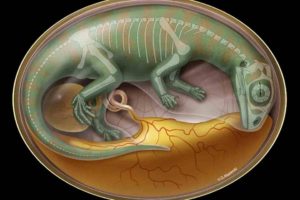
In the age of giant reptiles, sauropods were the biggest of all. Long-tailed, long-necked species like Diplodocus and Apatosaurus were the largest dinosaurs. From tip to tail, some sauropods were up to 40 metres long.
These giant herbivores ranged across the globe and thrived throughout the age of dinosaurs, nearly 150 million years.
“Sauropods are the one group that was successful from the beginning of the age of dinosaurs until the very end,” says Robert Reisz, a paleontologist and professor of biology at U of T Mississauga.
Despite their enormous size, sauropods had relatively small heads and mouths. They fed by ripping plant material from trees and bushes, and would have needed to eat almost constantly.
But sauropods did not have the extensive chewing capabilities of the large headed duckbill dinosaurs which are well known for their massive dental batteries. Instead, sauropods like titanosaurs and diplodocids evolved a different strategy for dealing with harsh, hard to process plant materials, using simplified, small, pencil shaped, rapidly growing new teeth that were worn down and replaced very quickly.
In research published in Nature Communications, Reisz examined fossils from the embryos of Lufengosaurus, an early sauropodomorph species that predates more recognizable sauropods like titanosaurs and diplodocids, which came later. Found in China’s Yunnan province, the fossils provided a record of Lufengosaurus at different stages of development, and showed distinct phases of tooth development.
In one of these phases, Lufengosaurus embryos had pencil-like teeth that resemble those found in some adult diplodocid and titanosaur sauropods. The finding suggests that the similar tooth structures that emerged in later sauropod species evolved through the retention of features present in the early stages of development of their distant predecessors.
“This evolutionary phenomenon, called paedomorphosis, is more frequently associated with small animals, but in this case, we seem to see it in big animals too,” Reisz says.
While Reisz’ sauropod research relied on rare embryo fossils, his examination of an even more ancient reptile relied upon a relative abundance of specimens.
Captorhinus aguti is a reptile that lived in the Permian Period (289 million years ago), well before the age of dinosaurs. In research published in Current Biology, Reisz studied 95 Captorhinus fossils to identify whether these four-legged reptiles displayed traits associated with brain lateralization—the asymmetrical brain function that can be observed in humans, birds, mammals and reptiles.
“The best-known lateralization is human right-handedness, and we know that right-handed people also prefer to eat on the right side,” says Reisz.
This project came about because Diane Scott, research assistant to Reisz, noticed that in one nearly perfect skull of this reptile one side of the dentition was more worn than the other side. Reisz’s team used the large number of lower jaws of this reptile, all from a single site, in order to understand it’s population-level chewing preferences.
“When you only have one specimen, it doesn’t really tell you a story,” says Reisz. “Maybe there was something wrong with that individual—a muscle anomaly that caused it to happen. But here, we have a population-level examination, all from a single pocket.”
The right jaws of Captorhinus showed more wear than the left, suggesting that even 289 million years ago, reptiles were displaying traits associated with brain asymmetry.
“It’s circumstantial evidence, but we think this indicates a subdivision of the brain, and suggests that functional brain asymmetry is a deeply nested phenomenon in vertebrate evolution, and this is the first time that we’ve seen it in fossils.”
Reference:
- Robert R. Reisz et al. Early Jurassic dinosaur fetal dental development and its significance for the evolution of sauropod dentition, Nature Communications (2020). DOI: 10.1038/s41467-020-16045-7
- Robert R. Reisz et al. Lateralized Feeding Behavior in a Paleozoic Reptile, Current Biology (2020). DOI: 10.1016/j.cub.2020.04.026
Note: The above post is reprinted from materials provided by University of Toronto Mississauga.










